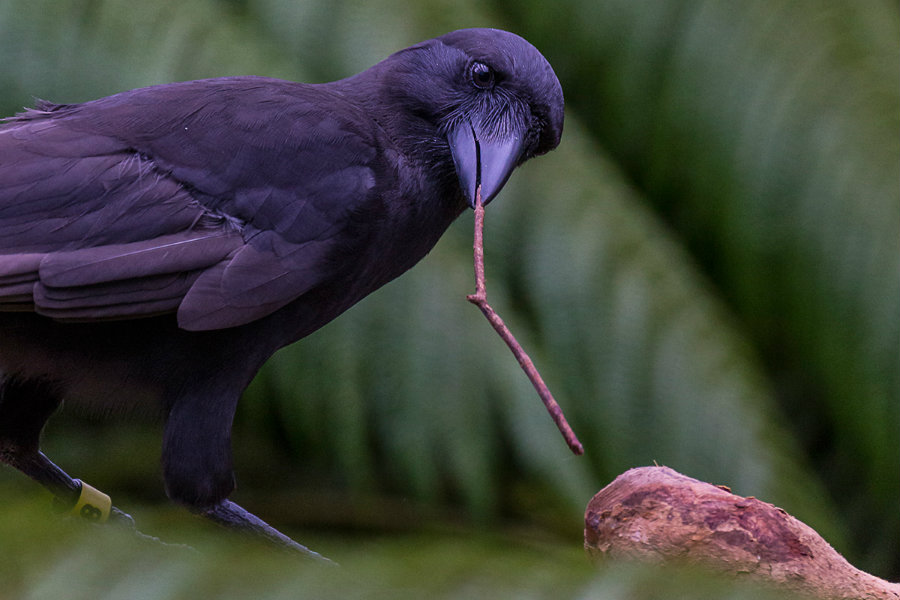The second tool-using crow species was recently discovered and studied to prove these animals are more evolved than people may think. The Hawaiian crows use sticks as New Caledonian crows to get food from difficult places. The research shows this ability is not learned, but instinctive, a eureka moment for biologists which means there is another species on the list of animals using tools to make easier their lives, just like humans do.
There are more than 40 crows and ravens and Christian Rutz, a behavioral ecologist at the University of St. Andrews and the lead author of the study, was sure there had to be more than one crow using sticks to get food.


Rutz has studied New Caledonian crows, who were the first member of the genus Corvus known for using tools in its habitat. They use twigs with their beaks to find food from unreachable places for them, and they even transform the twig into a hooks or barbs to adapt to the occasion.
Christian Rutz began his search of another corvid -a group that includes crows, ravens, and rooks- using tools based on New Caledonian. He started to search for crows with straight beaks and big eyes, similar to New Caledonian features, which Rutz believes makes it easier to manipulate stick and have a larger field of binocular vision. Binocular vision is the field of view that can be seen by both eyes at the same time, which enables most birds to perceive depth.
And after a quick image search, the researchers found the large, all-black Hawaiian crow, known locally as ‘alalā. This crow has straight, blunt beak, with relatively small eyes which still allows the Hawaiian species for depth perception. Rutz had to go to the San Diego Zoo to confirm of the bird was seen using tools before going to Hawaii to study them, and he proves his theory: The Hawaiian crow used sticks to do various activities.
The study: Confirming that crows use tools by their initiative or because they learn the ability from other mammals
Rutz and his team published their study Wednesday in the journal Nature, and it proves the Hawaiian crow hold twigs in its beak to dig for insects out of hard-to-reach spots.
The experiments involved two breeding facilities with a total of 104 birds because the Hawaiian crow has been extinct in the wild since the early 2000s. The crows were given puzzles where bait was tucked into crevices in a log, to let the bird known the food was there but out of reach.
The study found than 93 percent of the sexually mature Hawaiian crows would spontaneously pick up a stick and use it to dig when he knew the food was inside a hard-to-reach place.
The experiment was repeated with those crows that have been raised away from the tool-using adults. What scientist found was that the species does not need to learn the ability. The crows started to use twigs and learning by trial and error, suggesting there is a genetic component that makes the Hawaiian crow to instinctively used tools to satisfy its needs.
But Rutz explained this finding does not mean that Hawaiian crows have a “tool-using gene” or that they are programmed from birth to known what to do with a stick in case the bird cannot reach its food.
He says it is not as simple as that and continued explaining more likely these animals have a developmental program that is under the genetic influence that makes them engage with objects and explore their surroundings. But using the ability to experiment with tools is up to the individual and not genetics, similar to what happens with human toddlers.
This means the Hawaiian birds are probably predisposed to be curious about objects but not “designed” to explore their environment and find tools.
But because the research had to be done in breeders, scientists have to wait until groups are released into the wild to confirm that the species use tools under natural conditions. After almost being extinct, conservationists from the San Diego Zoo bred those remaining in captivity. There are just 109 known Hawaiian crows still alive in the world.
Even when they are separated by an ocean, New Caledonian crows and the Hawaiian crows have a lot in common
The fact that New Caledonian crows live more than 6 thousand kilometers away from the Hawaiian crows is evidence that tool use could be part of convergent evolution: the two species are evolved the same trait separately.
Rutz stated that from the Hawaiian crow tool use discovery, scientists could cautiously start constructing evolutionary arguments about the origin of tool use. This would enable broader comparisons, with non-tool using species, or with those that are well known for using tools before crows, such as primates.
Both Hawaiian and New Caledonian crows live in tropical areas, on small islands with very few predators, just like the Galapagos woodpecker, which is also known for using tools. Rutz stated questions could start to be asked about whether similar ecological conditions seemed to drive the evolution of this behavior in different parts of the animal kingdom.
Finding the Hawaiian crow abilities with sticks meant a new opportunity to talk about evolution because when you have a single species using tools, scientists had to explain a singularity. But now that there are more than one crow species using twigs to get food, the finding allows evolutionary questions and even to start speculating about the origin of tool use in humans, Rutz said.
The list of animals using tools has expanded over the years and included primates, elephants, dolphins, and sea otters. Still, only 1 percent of all species use instruments to adapt their environment to their needs.
Source: The Washington Post
